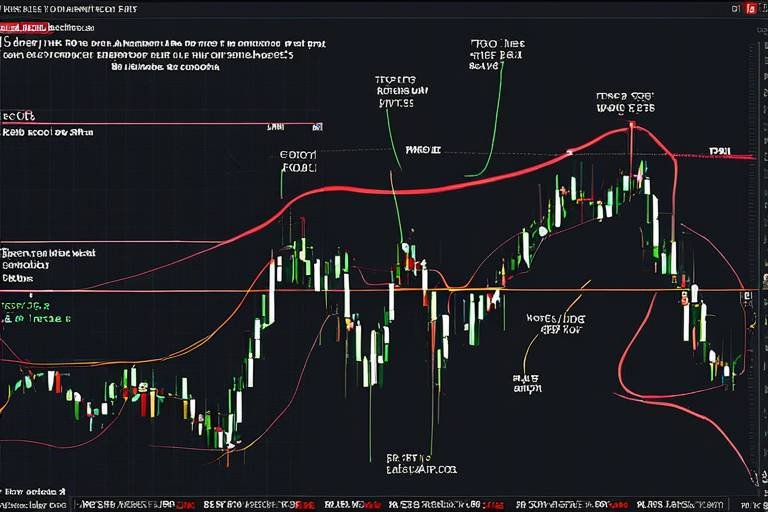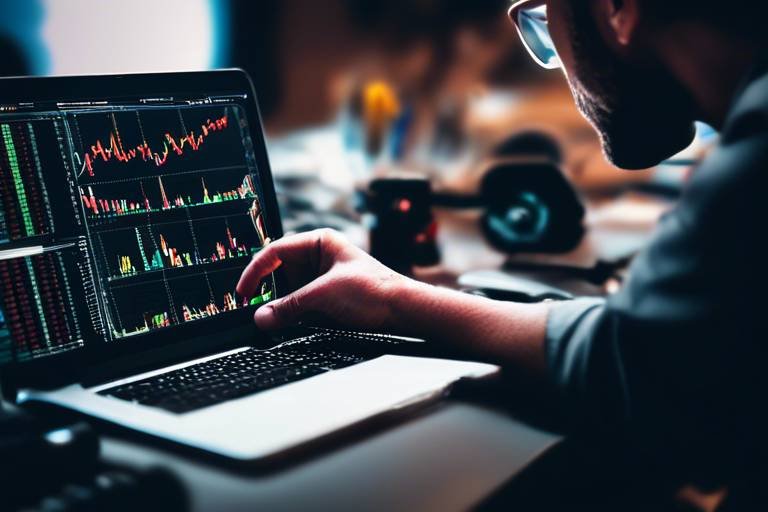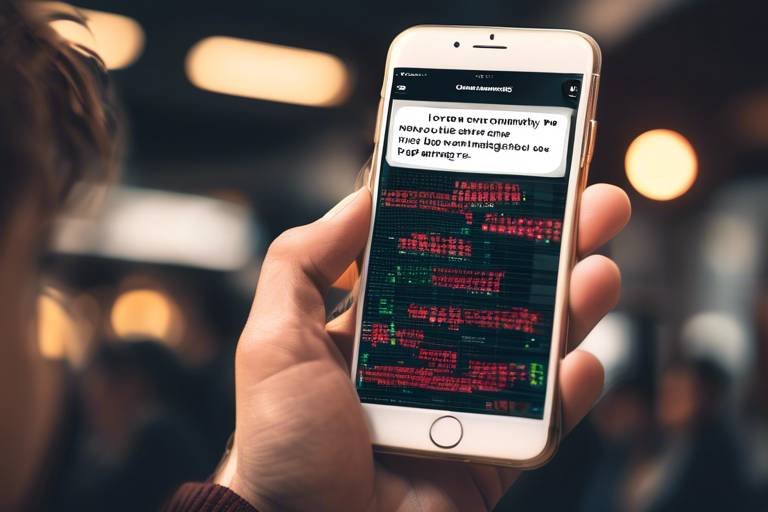Understanding the Risks of Day Trading Cryptocurrencies
Day trading cryptocurrencies can feel like riding a roller coaster. One moment, you’re on top of the world, watching your investments soar; the next, you’re plummeting down, heart racing as prices crash. The thrill is undeniable, but so are the risks that come with it. In this article, we’ll dive deep into the various risks associated with day trading in the crypto space. Whether you’re a novice or a seasoned trader, understanding these risks is crucial for navigating this volatile market and making informed decisions.
First off, let's talk about market volatility. The cryptocurrency market is known for its wild price swings. Unlike traditional stocks, which may fluctuate a few percentage points in a day, cryptocurrencies can experience double-digit changes within hours. This volatility can be both a blessing and a curse. While it presents opportunities for high returns, it also increases the chances of significant losses. For instance, a trader might buy Bitcoin at $50,000 only to see it drop to $45,000 within minutes. Understanding these fluctuations is essential for developing effective trading strategies and minimizing risks.
Another major risk factor is the emotional challenges that come with day trading. The fast-paced nature of the crypto market can evoke strong feelings like fear and greed. Have you ever found yourself staring at your screen, heart racing, as you watch a trade go south? You’re not alone! Many traders experience this emotional rollercoaster, which can lead to impulsive decisions and, ultimately, losses. Recognizing these psychological factors is crucial for maintaining discipline. Imagine trying to navigate a stormy sea without a compass; that’s what trading without emotional control feels like.
Let’s dig deeper into market volatility. Cryptocurrencies are notorious for their unpredictable price movements. This unpredictability can be attributed to various factors, including market sentiment, regulatory news, and technological advancements. For example, a tweet from a prominent figure can send prices skyrocketing or crashing. Understanding how these factors influence price fluctuations is vital. Traders must stay informed and be ready to adapt their strategies accordingly.
To illustrate this point, consider the following table that highlights some of the most volatile cryptocurrencies and their average daily price changes:
| Cryptocurrency | Average Daily Price Change (%) |
|---|---|
| Bitcoin (BTC) | 5-10% |
| Ethereum (ETH) | 6-12% |
| Ripple (XRP) | 8-15% |
| Litecoin (LTC) | 4-8% |
As you can see, the average daily price changes can be significant, highlighting the need for traders to be vigilant.
Now, let’s tackle the emotional challenges of day trading. The fear of missing out (FOMO) can be a trader's worst enemy. Have you ever watched a coin surge and thought, “I should have bought in!”? This feeling can lead to rash decisions, causing traders to jump into trades without proper analysis. It’s like trying to catch a bus that’s already left the station; you might just end up stranded.
Recognizing FOMO triggers is crucial for maintaining a level head. Ask yourself, what makes you feel anxious about missing out? Is it seeing friends or social media influencers making gains? Once you identify these triggers, you can develop strategies to combat them.
Understanding your personal triggers can help you manage your emotions effectively. Keeping a journal of your trading decisions and the emotions behind them can provide insights into your trading behavior. This self-awareness is key to avoiding impulsive trades based on FOMO.
Implementing pre-defined trading plans is a game-changer. By setting realistic goals and sticking to them, you can focus on your strategy rather than market hype. Think of it as having a roadmap for a long journey; it keeps you on track and prevents you from veering off course.
Stress management is another vital aspect of day trading. The pressure to make quick decisions can be overwhelming. Learning techniques to cope with this stress can significantly improve your decision-making and overall performance. Techniques such as deep breathing, taking breaks, or even engaging in physical activity can help clear your mind and refocus your energy on your trading strategies.
Finally, let’s discuss risk management techniques. Protecting your capital is essential for long-term success in day trading. Implementing effective strategies can help minimize losses while maximizing potential returns.
Stop-loss orders are a critical tool for limiting losses. By setting a predetermined price at which you will exit a trade, you can protect your investments from drastic price drops. It’s like having a safety net; it gives you peace of mind knowing you have a plan in place.
Determining the appropriate position size is key to managing risk. This involves calculating how much capital to allocate to each trade based on your individual risk tolerance and current market conditions. Think of it as balancing a scale; you want to ensure that you’re not overexposed to any single trade.
- What is day trading? Day trading involves buying and selling financial instruments within the same trading day, aiming to profit from short-term price movements.
- How can I minimize risks in day trading? Implement effective risk management strategies, set stop-loss orders, and maintain emotional discipline to minimize risks.
- Is day trading suitable for beginners? While it is possible for beginners to day trade, it's essential to educate yourself and practice with small amounts before diving in.
- What are the emotional challenges of day trading? Fear and greed are the primary emotional challenges, often leading to impulsive decisions and potential losses.

Market Volatility
Cryptocurrency markets are notoriously volatile, and this volatility is one of the main factors that attracts traders to the space. Imagine riding a roller coaster where the highs are exhilarating, but the lows can be gut-wrenching. In the world of cryptocurrencies, prices can swing dramatically within minutes, making it essential for day traders to understand how these fluctuations can impact their trading strategies. For instance, a coin might surge by 20% in a single hour, only to plummet by the same percentage shortly after. Such rapid changes can create both opportunities and risks, making it vital for traders to stay informed and agile.
Understanding market volatility involves recognizing that it is influenced by various factors, including market sentiment, news events, and regulatory changes. For example, a positive announcement regarding a cryptocurrency project can lead to a sudden influx of buyers, driving prices up. Conversely, negative news, such as regulatory crackdowns or security breaches, can trigger panic selling. This is why day traders must keep their ears to the ground and stay updated with the latest developments in the crypto space.
To further illustrate the impact of market volatility, consider the following table that highlights the average price changes of popular cryptocurrencies over a 24-hour period:
| Cryptocurrency | Average Price Change (%) |
|---|---|
| Bitcoin (BTC) | ±3.5% |
| Ethereum (ETH) | ±4.2% |
| Ripple (XRP) | ±5.0% |
| Litecoin (LTC) | ±3.8% |
As you can see, even the largest cryptocurrencies experience significant fluctuations. This means that day traders must be prepared to react quickly to changing market conditions. A well-thought-out trading strategy that accounts for this volatility can make all the difference between a profitable trade and a devastating loss.
In conclusion, market volatility is a double-edged sword. While it presents opportunities for substantial gains, it also poses risks that can lead to significant losses. Day traders who wish to succeed in this environment must develop a keen understanding of how market movements occur and be ready to adapt their strategies accordingly. Are you ready to ride the waves of volatility? Embrace the challenge, stay informed, and remember that every trader's journey is unique!

Emotional Challenges
Day trading cryptocurrencies is not just about numbers and charts; it's a rollercoaster of emotions that can leave even the most seasoned traders feeling dizzy. The thrill of making quick profits can quickly turn into a nightmare when the market takes an unexpected turn. Understanding the emotional challenges that come with day trading is crucial for anyone looking to navigate this wild ride. Emotions like fear and greed can cloud judgment and lead to impulsive decisions that can have devastating consequences.
One of the most significant emotional hurdles traders face is the Fear of Missing Out, commonly known as FOMO. This feeling can be incredibly powerful, driving traders to jump into trades without proper analysis simply because they see others making profits. It's like watching a friend score a goal in a soccer match; you want to be part of the action, but rushing in without a game plan can lead to serious mistakes. Recognizing when FOMO kicks in is the first step toward regaining control over your trading strategy.
FOMO can lead traders to make impulsive decisions that they may later regret. It's essential to identify the triggers that spark this emotional response. For instance, seeing a sudden price spike in a cryptocurrency can create an overwhelming urge to buy, even if the fundamentals don’t support such a move. To combat this, traders should develop a set of rules or guidelines to follow. By establishing a pre-defined trading plan, you can reduce the chances of acting on impulse. Think of it as having a map before embarking on a journey; it helps you stay on the right path, no matter how tempting the detours may seem.
Understanding personal triggers for FOMO can aid traders in managing their emotions. For example, if you notice that you tend to act on FOMO when you’re stressed or tired, it might be wise to take a break during those times. Keeping a journal to track your trades and the emotions you felt during each one can provide valuable insights. By identifying patterns, you can better prepare yourself for future trades, ensuring that you make rational decisions based on analysis rather than impulsive reactions.
Implementing strategies to combat FOMO is essential for maintaining discipline in day trading. Here are a few techniques that can help:
- Set Realistic Goals: Establish achievable profit targets to keep your expectations in check.
- Stick to Your Plan: Create a trading plan that outlines your entry and exit points, and adhere to it, regardless of market hype.
- Limit Social Media Exposure: Reduce the time spent on social media platforms where traders often share their successes, as this can trigger FOMO.
By focusing on your strategies rather than external pressures, you can make more informed decisions that align with your trading goals.
Stress management is vital for day traders. The fast-paced nature of the cryptocurrency market can create immense pressure, affecting your ability to make sound decisions. It's essential to learn techniques to cope with this stress. Whether it's through mindfulness practices, regular exercise, or simply taking breaks to clear your mind, finding what works for you can significantly improve your trading performance. Just like a well-tuned engine runs smoothly, a calm and focused mind can lead to better trading outcomes.

Fear of Missing Out (FOMO)
The phenomenon known as Fear of Missing Out, or FOMO, is a powerful emotional trigger that can significantly impact day traders in the cryptocurrency market. Imagine standing at a party and watching everyone enjoy themselves while you're stuck outside; that feeling of being left out can lead to impulsive decisions. In the trading world, this manifests as a rush to buy into a cryptocurrency just because others are doing so, often without proper analysis or strategy. This emotional response can cloud judgment and lead to rash trades that may not align with a trader's overall strategy or risk tolerance.
FOMO is particularly prevalent in the cryptocurrency market due to its high volatility and the rapid pace at which news spreads. Traders often find themselves glued to their screens, watching prices fluctuate and feeling the pressure to act quickly. This can create a cycle where the fear of missing out on potential profits drives traders to make hasty decisions, ultimately leading to losses. Recognizing the signs of FOMO is crucial; if you find yourself trading simply because you see others making profits, it might be time to take a step back and reassess your strategy.
So, how can traders identify and manage their FOMO triggers? Here are a few strategies:
- Self-Reflection: Take time to understand what specific situations trigger your FOMO. Is it a sudden price spike or a friend's success story?
- Set Clear Goals: Establish your trading goals and stick to them. Having a clear plan can help you resist the urge to chase after every opportunity.
- Limit Exposure: Reduce the time spent on social media and trading forums. The less you expose yourself to the hype, the less likely you are to feel pressured to act.
By implementing these strategies, traders can better manage their emotions and make more informed, rational decisions. Remember, the cryptocurrency market will always present opportunities, and it’s essential to approach trading with a level head rather than succumbing to the fear of missing out.
What is FOMO in trading?
FOMO, or Fear of Missing Out, is an emotional response that can lead traders to make impulsive decisions based on the fear of missing potential profits.
How can I identify my FOMO triggers?
Self-reflection is key. Take note of situations that make you feel anxious about missing out, such as sudden price increases or seeing others profit.
What strategies can help combat FOMO?
Setting clear trading goals, limiting exposure to social media, and having a well-defined trading plan can help mitigate the effects of FOMO.
Is FOMO common among cryptocurrency traders?
Yes, due to the volatile nature of the cryptocurrency market and the rapid spread of information, FOMO is a common challenge that many traders face.

Recognizing FOMO Triggers
Fear of Missing Out, or FOMO, is a powerful emotion that can significantly impact a trader's decision-making process. In the fast-paced world of cryptocurrency trading, where prices can skyrocket in a matter of minutes, it’s easy to get swept up in the excitement. But what exactly triggers FOMO? Recognizing these triggers is essential for maintaining a level head and making informed decisions.
One common trigger is the social media buzz. When you see posts about a coin that’s rapidly gaining value, it can create a sense of urgency. You might think, “If I don’t buy now, I’ll miss out!” This emotional reaction can lead to impulsive buying, often resulting in losses when the price corrects. Another trigger is peer pressure. If friends or fellow traders are investing in a particular asset, you might feel compelled to follow suit, even if it doesn’t align with your trading strategy.
Additionally, market news can exacerbate FOMO. Positive news articles or endorsements from influential figures can spark a buying frenzy. It’s crucial to differentiate between genuine opportunities and hype-driven trends. To help you identify these triggers, consider the following:
- Monitor your emotional responses when viewing market updates or social media.
- Reflect on past trades influenced by FOMO and their outcomes.
- Establish a set of criteria for making trades, which can serve as a buffer against impulsive decisions.
By being aware of these triggers, you can develop a more disciplined approach to trading. Remember, it’s not just about what everyone else is doing; it’s about sticking to your plan and making decisions based on thorough analysis rather than emotional impulses. This awareness can empower you to make rational choices, ultimately enhancing your trading success.
Q: What is FOMO in trading?
A: FOMO, or Fear of Missing Out, refers to the anxiety that traders feel when they believe they might miss out on a profitable opportunity. This can lead to impulsive trading decisions.
Q: How can I manage FOMO?
A: To manage FOMO, it’s important to create a trading plan, set clear goals, and stick to your strategy. Avoid making decisions based solely on market hype or social media influence.
Q: What are some signs that I am experiencing FOMO?
A: Signs of FOMO include feeling anxious when you see others making profits, rushing to buy assets without research, and frequently checking market updates to see if prices are rising.

Strategies to Combat FOMO
Fear of Missing Out, or FOMO, can be a significant hurdle for day traders, especially in the fast-paced world of cryptocurrencies. It’s that nagging feeling that everyone else is making profits while you’re sitting on the sidelines. But fear not! There are effective strategies to combat this emotional beast and keep your trading on the right track.
First and foremost, having a pre-defined trading plan is essential. This plan should outline your entry and exit points, as well as your risk tolerance for each trade. By sticking to this plan, you create a structured approach that minimizes the chances of impulsive decisions driven by FOMO. Remember, trading without a plan is like sailing without a compass—you might drift aimlessly and end up in treacherous waters.
Another effective strategy involves setting realistic goals. Instead of chasing after every market wave, define what success looks like for you. This could mean aiming for a specific percentage gain each month or focusing on the number of trades you make rather than their outcomes. By having clear, achievable goals, you can redirect your focus from what others are doing to your own performance.
Additionally, consider keeping a trading journal. Documenting your trades, the rationale behind them, and the emotions you experienced can provide valuable insights. Over time, you’ll start to notice patterns in your behavior, particularly when FOMO strikes. This self-awareness can empower you to recognize when you’re about to make an impulsive decision and help you steer back to your original plan.
Lastly, it’s crucial to limit exposure to social media and news that may trigger FOMO. While it’s important to stay informed, the constant barrage of success stories and market updates can lead to anxiety and rash decisions. Instead, curate your information sources and set specific times to check updates. This way, you can maintain a level of detachment from the noise and focus on what truly matters—your trading strategy.
In summary, combating FOMO is all about creating a solid foundation for your trading practices. By developing a pre-defined trading plan, setting realistic goals, keeping a trading journal, and managing your information intake, you can maintain a level-headed approach to day trading. Remember, the market will always be there—there’s no need to rush into decisions that could jeopardize your financial health.
- What is FOMO in trading? FOMO stands for Fear of Missing Out, which is the anxiety that traders feel when they believe others are profiting from a market opportunity that they are missing.
- How can I recognize my FOMO triggers? By keeping a trading journal, you can identify patterns in your emotions and decisions, helping you recognize when FOMO is influencing your trading.
- What are stop-loss orders? Stop-loss orders are automated trades that close your position at a predetermined price to limit potential losses.
- Why is a trading plan important? A trading plan provides structure and discipline, helping you avoid impulsive decisions driven by emotions like FOMO.

Managing Stress
Day trading isn't just about numbers and charts; it's a high-stakes emotional rollercoaster that can leave even the most seasoned traders feeling overwhelmed. The fast-paced nature of the cryptocurrency market can lead to significant stress, which, if left unchecked, can cloud your judgment and impact your trading decisions. So, how can you manage this stress and maintain your cool while navigating the turbulent waters of crypto trading?
First off, recognizing the sources of stress is crucial. For many traders, it might stem from the fear of losing money, missing out on potential gains, or even the pressure to keep up with market trends. By identifying what specifically triggers your stress, you can begin to implement strategies to counteract it.
One effective method for managing stress is to develop a structured trading routine. Having a clear plan can provide a sense of control and predictability in a chaotic environment. This routine might include setting specific trading hours, defining your entry and exit points, and sticking to your predetermined risk management strategies. When you have a plan, it’s easier to avoid impulsive decisions driven by stress or anxiety.
Additionally, incorporating mindfulness techniques into your daily routine can significantly help in stress management. Practices such as meditation, deep-breathing exercises, or even short walks can help clear your mind and reduce anxiety levels. These techniques allow you to step back from the screen and regain your composure, enabling you to approach your trades with a fresh perspective.
Moreover, it's essential to maintain a healthy work-life balance. Day trading can easily consume your time and energy, but neglecting other aspects of your life can lead to burnout. Make sure to allocate time for hobbies, exercise, and socializing. Engaging in activities outside of trading can provide you with necessary mental breaks and reduce overall stress levels.
Finally, don't hesitate to seek support from fellow traders or professionals. Joining a trading community can provide a platform for sharing experiences, strategies, and coping mechanisms. Sometimes, just knowing that others face similar challenges can alleviate feelings of isolation and stress.
In summary, managing stress while day trading cryptocurrencies is not just about avoiding losses; it's about maintaining a clear mind and making informed decisions. By recognizing your stress triggers, establishing a structured routine, practicing mindfulness, balancing your personal life, and seeking community support, you can navigate the ups and downs of the crypto market with greater confidence and resilience.
- What are the main causes of stress in day trading?
Stress can arise from various factors including fear of loss, market volatility, and the pressure to perform consistently. - How can I quickly reduce stress during trading hours?
Techniques such as deep breathing, taking short breaks, and stepping away from the screen can help alleviate immediate stress. - Is it beneficial to have a trading routine?
Yes, a structured trading routine can provide clarity and control, helping to minimize impulsive decisions driven by stress. - What role does community play in managing trading stress?
Being part of a trading community offers support and shared experiences, which can help reduce feelings of isolation and anxiety.

Risk Management Techniques
When it comes to day trading cryptocurrencies, understanding and implementing effective is not just important—it's absolutely essential. The cryptocurrency market is known for its wild price swings, which can either lead to significant gains or devastating losses. Thus, having a solid risk management plan can be the difference between a successful trading career and one filled with regret. But what does risk management truly entail? Let's delve into some key strategies that every trader should consider.
One of the most fundamental techniques in risk management is setting stop-loss orders. These are pre-determined price levels at which a trader will exit a position in order to limit losses. For example, if you buy Bitcoin at $50,000 and set a stop-loss order at $48,000, your trade will automatically close if the price drops to that level, preventing further losses. Understanding how to effectively set these orders can help you navigate the volatile waters of cryptocurrency trading.
Another crucial aspect of risk management is position sizing. This involves determining how much capital you should allocate to each trade based on your overall portfolio size and individual risk tolerance. For instance, a common rule of thumb is to risk no more than 1% of your total trading capital on a single trade. This means if you have a $10,000 trading account, you would only risk $100 on any given trade. By controlling the amount of capital you expose to risk in each trade, you can protect your account from significant drawdowns.
| Risk Management Technique | Description |
|---|---|
| Stop-Loss Orders | Automatically exit a trade at a predetermined price to limit losses. |
| Position Sizing | Determining the amount of capital to allocate to each trade based on risk tolerance. |
| Diversification | Spreading investments across various cryptocurrencies to reduce risk. |
| Risk-Reward Ratio | Evaluating potential profit against potential loss before entering a trade. |
In addition to stop-loss orders and position sizing, diversification is another effective strategy. By spreading your investments across multiple cryptocurrencies, you can mitigate the risk associated with any single asset. Think of it like not putting all your eggs in one basket; if one cryptocurrency performs poorly, the others may still yield positive returns, balancing out your overall portfolio performance.
Lastly, understanding the risk-reward ratio is vital. Before entering a trade, evaluate how much you stand to gain versus how much you could potentially lose. A good rule of thumb is to aim for a risk-reward ratio of at least 1:2. This means for every dollar you risk, you should aim to make two dollars. By doing so, even if you have a few losing trades, your profitable trades can still keep your account in the green.
In summary, effective risk management techniques like setting stop-loss orders, determining proper position sizes, diversifying your investments, and understanding the risk-reward ratio can significantly enhance your trading experience. By implementing these strategies, you can minimize potential losses while maximizing your chances for success in the ever-changing cryptocurrency market.
- What is a stop-loss order? A stop-loss order is a predetermined price level at which a trader will exit a trade to limit losses.
- How do I determine my position size? Position size is calculated based on your total trading capital and the percentage of that capital you are willing to risk on a single trade.
- Why is diversification important? Diversification helps reduce risk by spreading investments across different assets, so if one performs poorly, others may perform well.
- What is a good risk-reward ratio? A risk-reward ratio of at least 1:2 is generally recommended, meaning you aim to gain twice what you risk.

Setting Stop-Loss Orders
Stop-loss orders are a fundamental tool in the arsenal of any day trader, especially in the unpredictable world of cryptocurrencies. They serve as a safety net, allowing traders to set predetermined exit points for their trades, thus minimizing potential losses. But what exactly is a stop-loss order? In simple terms, it's an instruction to sell a cryptocurrency when it reaches a specified price. This can help prevent emotional decision-making during volatile market conditions, where prices can swing dramatically in a short period.
To effectively utilize stop-loss orders, traders need to understand not just how to set them, but also when and where to place them. For instance, placing a stop-loss too close to the current market price might result in being stopped out on minor fluctuations, whereas placing it too far away could expose the trader to significant losses. Thus, finding the right balance is crucial. A common approach is to set the stop-loss at a percentage below the entry price, which can vary based on the trader's risk tolerance and the specific characteristics of the cryptocurrency being traded.
Let’s consider a hypothetical scenario: imagine you buy Bitcoin at $40,000 and decide to set a stop-loss order at 5% below that price. This means your stop-loss would be set at $38,000. If Bitcoin's price drops to this level, your stop-loss order would trigger a sale, helping you to limit your loss to $2,000. This strategy allows you to manage your risk effectively while still participating in the market's potential upside.
Here are some key considerations when setting stop-loss orders:
- Market Conditions: Always consider the overall market trend. In a bullish market, you might want to adjust your stop-loss to lock in profits as the price rises.
- Volatility: Cryptocurrencies are known for their volatility. Setting a stop-loss too tight in a highly volatile market can lead to frequent stop-outs.
- Technical Analysis: Use support and resistance levels to inform your stop-loss placement. Setting it just below a key support level can provide a buffer against minor dips.
In conclusion, setting stop-loss orders is not just about protecting your capital; it's about creating a disciplined approach to trading. By incorporating stop-loss orders into your trading strategy, you can minimize emotional trading decisions and maintain a more structured approach to your investments. Remember, the goal of day trading is not just to make profits but to preserve your capital for future trades. So, take the time to understand how to set your stop-loss orders effectively, and watch as it transforms your trading experience.
1. What is a stop-loss order?
A stop-loss order is an instruction to sell a cryptocurrency when it reaches a specified price, helping to limit potential losses.
2. How do I determine where to set my stop-loss?
You can set your stop-loss based on a percentage of the entry price, market conditions, and key support and resistance levels.
3. Can stop-loss orders guarantee that I won’t lose money?
While stop-loss orders can help minimize losses, they cannot guarantee that you won't lose money, especially in highly volatile markets where prices can gap down.
4. Should I use a fixed or trailing stop-loss?
It depends on your trading strategy. A fixed stop-loss is set at a specific price, while a trailing stop-loss adjusts automatically as the price moves in your favor, locking in profits.

Position Sizing
When it comes to day trading cryptocurrencies, one of the most critical aspects that traders often overlook is . This concept is not just about how much you can afford to lose; it's about calculating the right amount of capital to allocate to each trade based on your overall portfolio and risk tolerance. Think of position sizing as the foundation of your trading strategy—without a solid base, your trading house might just crumble when the market gets rocky.
To effectively manage your risk, you first need to determine your risk tolerance. This involves asking yourself questions like: How much of my total capital am I willing to risk on a single trade? A common rule of thumb is to risk no more than 1-2% of your total trading capital on any one trade. For instance, if your trading capital is $10,000, you should ideally risk between $100 and $200 on a single trade. This approach helps to ensure that even if you hit a series of losing trades, your overall capital remains intact.
Now, let’s break down the process of position sizing into a simple formula. The formula can be summarized as follows:
| Component | Description |
|---|---|
| Account Size | Your total trading capital. |
| Risk Percentage | The percentage of your account you're willing to risk on a trade. |
| Trade Risk | The difference between your entry price and stop-loss price. |
| Position Size | (Account Size x Risk Percentage) / Trade Risk |
Using this formula, you can quickly determine how many units of a cryptocurrency you should buy or sell. For example, if your account size is $10,000, you decide to risk 2% (or $200), and your trade risk is $10 (the difference between your entry price and stop-loss), your position size would be:
Position Size ($10,000 x 0.02) / $10 Position Size $200 / $10 Position Size 20 units
By knowing the correct position size, you’re not just gambling; you’re making informed decisions that align with your risk management strategy. This disciplined approach can significantly enhance your trading performance over time.
In addition to calculating your position size, it's essential to continually evaluate and adjust your strategy based on market conditions. Just like a seasoned sailor adjusts their sails according to the wind, successful traders adapt their position sizes as the market evolves. This flexibility can be the difference between a successful trading career and one filled with regret.
In conclusion, mastering position sizing is a crucial skill for any day trader looking to navigate the volatile waters of cryptocurrency trading. By understanding your risk tolerance, using the formula to determine your position size, and remaining adaptable to market changes, you can protect your capital and enhance your chances of success.
- What is position sizing? Position sizing refers to the amount of capital allocated to a single trade based on risk tolerance and account size.
- Why is position sizing important? Proper position sizing helps manage risk, ensuring that no single loss can significantly impact your overall trading capital.
- How do I determine my risk tolerance? Your risk tolerance can be determined by assessing your financial situation, trading goals, and emotional responses to losses.
- Can I adjust my position size based on market conditions? Absolutely! Being flexible with your position size can help you adapt to changing market dynamics.
Frequently Asked Questions
- What are the main risks of day trading cryptocurrencies?
The main risks include market volatility, emotional challenges, and the potential for significant financial losses. Cryptocurrencies can experience rapid price changes, which can lead to both opportunities and threats for traders.
- How can I manage the emotional challenges of day trading?
To manage emotional challenges, it's important to recognize triggers such as fear of missing out (FOMO) and to develop strategies to combat them. This might involve setting predefined trading plans and sticking to them, regardless of market hype.
- What is FOMO and how does it affect traders?
FOMO, or fear of missing out, is the anxiety that traders feel when they see others making profits. This can lead to impulsive decision-making. Recognizing FOMO triggers can help traders stay disciplined and make rational choices based on analysis rather than emotions.
- What are stop-loss orders and why are they important?
Stop-loss orders are automatic instructions to sell a cryptocurrency when it reaches a certain price. They are crucial for limiting losses in a volatile market, allowing traders to protect their investments without having to monitor the market constantly.
- How do I determine the right position size for my trades?
Determining the appropriate position size involves calculating how much capital to allocate to each trade based on your individual risk tolerance and the current market conditions. A common rule is to risk only a small percentage of your total capital on any single trade.
- What strategies can I use to mitigate risks in day trading?
Some effective strategies include setting stop-loss orders, diversifying your investments, and using proper position sizing. Additionally, maintaining a disciplined trading plan and managing your emotions can significantly reduce risks.
- Can I day trade cryptocurrencies with a small amount of capital?
Yes, you can day trade cryptocurrencies with a small amount of capital, but it's essential to be aware of the risks involved. Start with a clear strategy, use proper risk management techniques, and be prepared for the potential of losing your investment.
- How can I improve my decision-making under stress while trading?
Improving decision-making under stress can involve practicing stress management techniques such as deep breathing, taking breaks, and maintaining a healthy work-life balance. Keeping a clear mind can help you analyze trades more effectively.



















